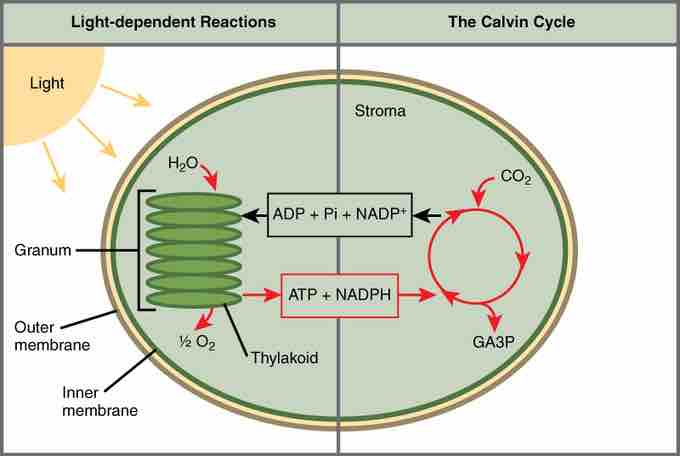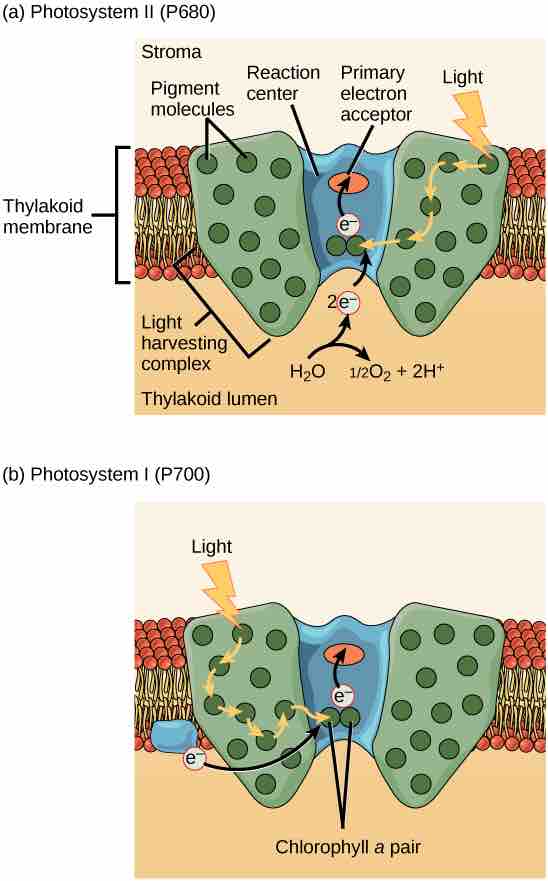Photosynthesis takes place in two sequential stages:
- The light-dependent reactions;
- The light-independent reactions, or Calvin Cycle.
Light-Dependent Reactions
Just as the name implies, light-dependent reactions require sunlight. In the light-dependent reactions, energy from sunlight is absorbed by chlorophyll and converted into stored chemical energy, in the form of the electron carrier molecule NADPH (nicotinamide adenine dinucleotide phosphate) and the energy currency molecule ATP (adenosine triphosphate). The light-dependent reactions take place in the thylakoid membranes in the granum (stack of thylakoids), within the chloroplast.

The two stages of photosynthesis
Photosynthesis takes place in two stages: light-dependent reactions and the Calvin cycle (light-independent reactions). Light-dependent reactions, which take place in the thylakoid membrane, use light energy to make ATP and NADPH. The Calvin cycle, which takes place in the stroma, uses energy derived from these compounds to make GA3P from CO2.
Photosystems
The process that converts light energy into chemical energy takes place in a multi-protein complex called a photosystem. Two types of photosystems are embedded in the thylakoid membrane: photosystem II ( PSII) and photosystem I (PSI). Each photosystem plays a key role in capturing the energy from sunlight by exciting electrons. These energized electrons are transported by "energy carrier" molecules, which power the light-independent reactions.
Photosystems consist of a light-harvesting complex and a reaction center. Pigments in the light-harvesting complex pass light energy to two special chlorophyll a molecules in the reaction center. The light excites an electron from the chlorophyll a pair, which passes to the primary electron acceptor. The excited electron must then be replaced. In photosystem II, the electron comes from the splitting of water, which releases oxygen as a waste product. In photosystem I, the electron comes from the chloroplast electron transport chain.
The two photosystems oxidize different sources of the low-energy electron supply, deliver their energized electrons to different places, and respond to different wavelengths of light.

Photosystems I & II
As explained above, the photosystems manipulate electrons with energy harvested from light.
Light-Independent Reactions
In the light-independent reactions or Calvin cycle, the energized electrons from the light-dependent reactions provide the energy to form carbohydrates from carbon dioxide molecules. The light-independent reactions are sometimes called the Calvin cycle because of the cyclical nature of the process.
Although the light-independent reactions do not use light as a reactant (and as a result can take place at day or night), they require the products of the light-dependent reactions to function. The light-independent molecules depend on the energy carrier molecules, ATP and NADPH, to drive the construction of new carbohydrate molecules. After the energy is transferred, the energy carrier molecules return to the light-dependent reactions to obtain more energized electrons. In addition, several enzymes of the light-independent reactions are activated by light.